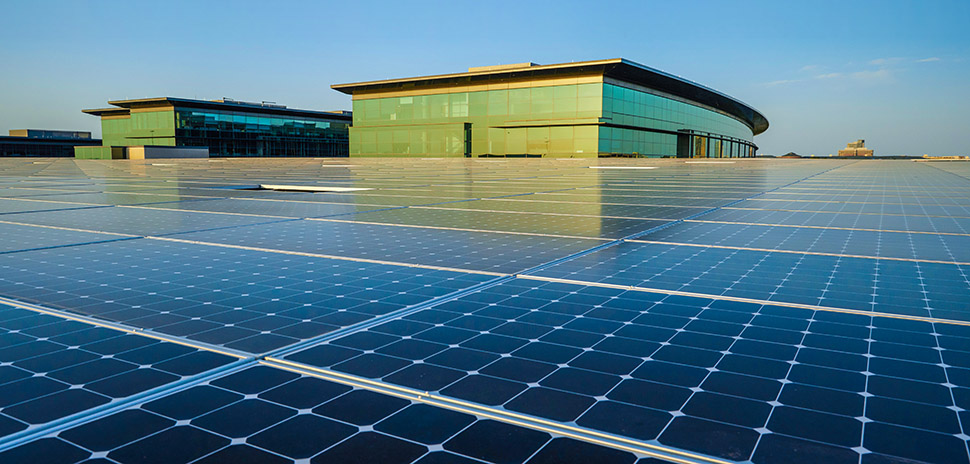A year ago, Dallas-Fort Worth might not have come to mind when ranking the most sustainable regions, but progressive city codes, innovative developers and designers, and large corporate companies are changing that.
The word “green” as a moniker for sustainability and environmentally conscious real estate typically elicits thoughts of coastal cities such as San Francisco or Boston. But don’t write DFW off just yet.
Architects, developers, and thought leaders within the sustainability community say the region is underrated. While the Dallas-Fort Worth region may have room to grow in the rankings of the nation’s greenest cities — those that use the most renewable energy, offer the best public transit, or have an environmental impact at the center of many public policies — it’s just getting started.
“In some areas, we’re ahead of a lot of the country,”
Jonathan Kraatz
“In some areas, we’re ahead of a lot of the country,” U.S. Green Building Council-Texas Chapter Executive Director Jonathan Kraatz says, citing public policies in the region’s largest cities. Dallas was one of the first major cities to champion and pass comprehensive standards for sustainable building practices in 2008.
The Fort Worth Better Buildings Challenge, sponsored by the U.S. Department of Energy, aims to decrease energy consumption by one-fifth by 2020. Many other local cities have adopted incentive-based programs to encourage developers to pursue third-party certifications, such as the USGBC’s Leadership in Energy and Environmental Design (LEED) designations.
And it’s working. Dallas-Fort Worth has 149,146,781 square feet of a LEED-certified real estate, according to the USGBC, accounting for 682 commercial projects.
This summer, Site Selection magazine named Dallas-Fort Worth-Arlington as No. 8 on its list of the Top 10 Metros in its 2018 Sustainability Rankings. And, a recent Abodo study ranked Dallas-Fort Worth-Arlington as the ninth highest metro area for LEED-certified real estate by square footage.
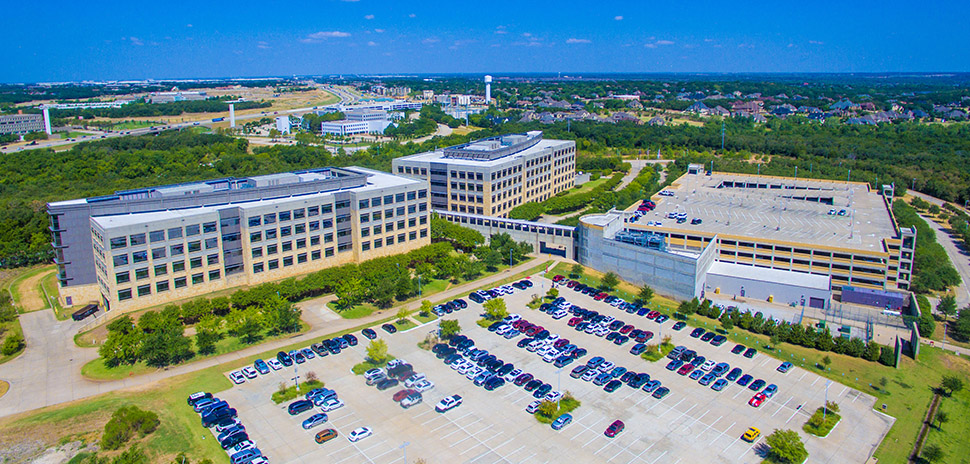
Sabre Corp.’s Southlake campus [Photo: Michael Samples]
LEED, first launched as a pilot in 1998, is a credit-based certification that has many versions to account for project types (i.e. residential or commercial) and types of certification (i.e. building design and construction or operations and maintenance).
“Our concern is the built environment, and many pieces go into that—energy use, materials, indoor air quality, water use,” Kraatz says. “We’re looking at having a built environment that is better for the planet and the people on it, but it’s also a profitable venture for those operating it. If those things don’t balance out, none will survive.” Approaching the latter—profitability—often resonates more with Dallas-Fort Worth decision makers.
“Dallas is a very business-oriented city and … our cities are going to have to become more regenerative to continue to attract and retain corporate clients,” HKS Principal and COO Kirk Teske says.
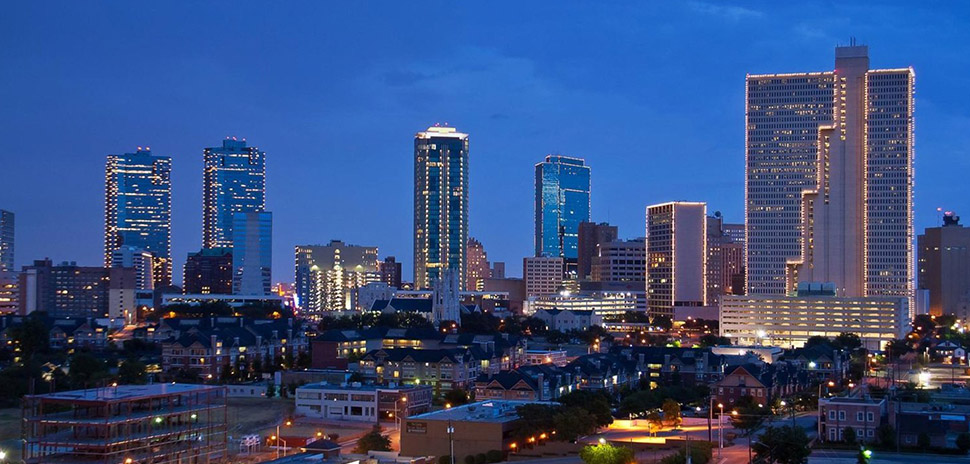
Built in 1983 before LEED was invented, Burnett Plaza in Fort Worth achieved LEED Silver in 2012, as well as the EPA’s Energy Star rating . (photo: leekris via iStock)
When considering how DFW stacks up to other metros, Teske says demand for “green” projects is still relatively low, but rethinking how designers approach conversations about sustainability can have a positive response. When designers or developers can prove to building owners, lenders, or investors that, say, lowering energy or water usage positively impacts the bottom line, they’re more likely to pursue environmentally conscious practices.
Dallas Innovates, Every Day: Sign up to keep your eye on what’s new and next in Dallas-Fort Worth, every day.
What makes construction sustainable?
Buildings are capable of significantly impacting energy consumption when it comes to factors such as production, operation, and maintenance. Sustainable construction incorporates environmentally efficient elements that contribute positively to the future of the area, such as lowering greenhouse gas emissions.
Successful sustainable construction meets economic and social needs while remaining ecologically conscious—but that doesn’t necessarily mean it’s LEED certified.
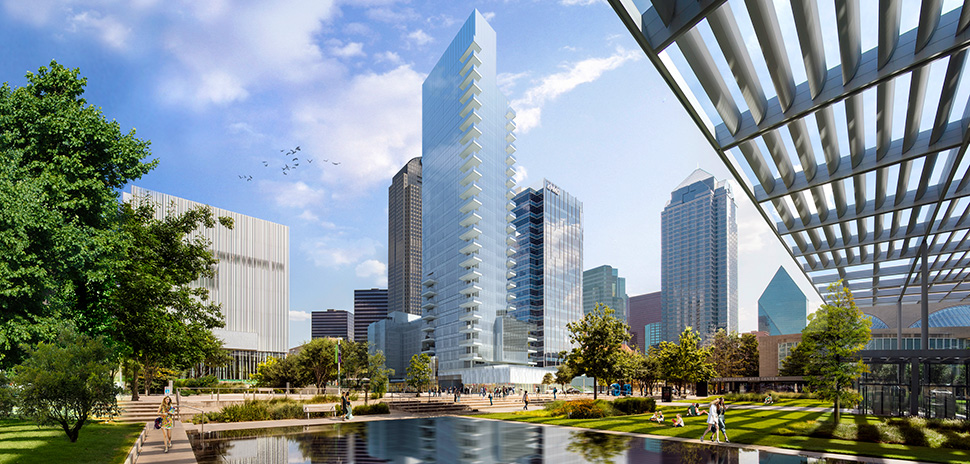
Hall Arts Residences could be the first registered well-certified multifamily building when the project is completed in 2020. [Rendering: Hall Group]
Some industry experts in DFW say that LEED doesn’t have as much appeal as it did a decade ago. Kyle Whitesell, executive vice president of Arlington-based Bob Moore Construction, says it’s mainly large corporations that take the LEED route, while smaller clients steer towards meeting baseline state environmental codes. Sustainability Manager at CxL Building Services Jolene Young, who works with numerous construction companies in the DFW area, agreed.
“The biggest trend we’ve seen is that city, county, and state environmental code regulations have been catching up to LEED certification standards the last few years.”
Kyle Whitesell
“The biggest trend we’ve seen is that city, county, and state environmental code regulations have been catching up to LEED certification standards the last few years,” Whitesell says.
“It’s going to be up to local governments to implement new environmental code if DFW is going to become a ‘greener’ metro area.”
While DFW is on its way to a more sustainable future, major steps need to be taken that go beyond the fundamentals — a challenge that will require tapping into renewable solutions, according to Corgan Design Director Chuck Armstrong.
“Renewable power sources, notably solar power collectors and wind generators, ease demand on the electric grid and start to answer the question of what can we do on any given site to not only reduce power consumption, but to also make our own power,” says Armstrong, adding, “Evolving and improved battery technologies are beginning to provide stronger solutions for storing extra power until it is needed.”
The competitive factor
Beyond the environmental impact, sustainability can offer a competitive advantage for companies. As recruiting and retaining top-notch talent becomes ever more important, businesses are increasingly looking to differentiate themselves and their office space. Sustainability and wellness can help employers do that, experts say. Employee wellness — a close cousin of sustainability — has emerged as a key differentiator.
Many third-party certifications are emerging to help companies measure up. DPR’s Chris Gorthy calls such benchmarks “super deep green.”
Businesses that offer sit-stand desks, access to walking trails or fitness amenities, and natural daylight in workspaces, have a leg up on ones that don’t.
And as the wellness field gains traction, more and more academic research emerges proving that employees are more productive and healthier in wellness-minded work environments, thereby saving employers on turnover and health-care costs.
Like LEED in the sustainability realm, many third-party certifications are emerging to help companies measure up. DPR’s Chris Gorthy calls such benchmarks “super deep green.”
He’s being asked by more and more local and national clients about certifications beyond LEED, such as Living Future Institute’s (ILFI) Zero Energy Building (ZEB) Certification or Delos’ Well Building Standard. “If CEOs would understand this — it has a bigger impact on the bottom line,” Gorthy says.
In Dallas-Fort Worth, both sustainability and wellness are poised to gain traction for two reasons. First, the region is densifying and becoming more urban. “Sustainability standards often come into play because of transit or density. Texas has always had more land available. But as [Dallas-Fort Worth] has gotten denser in the last five or 10 years, now is the time people are thinking about these strategies,” Gorthy says.
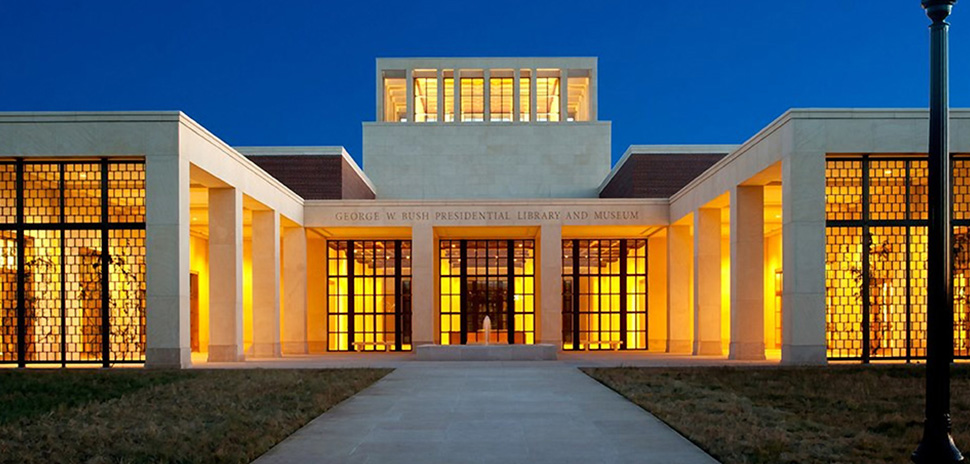
The Bush Presidential Center at Southern Methodist University in Dallas achieved Platinum certification by the U.S. Green Building Council—the first presidential library to achieve that status. According to its website, the center features green roofing systems that reduce heating and cooling demands, solar panels for producing electricity and hot water, building materials that were sourced from the North Texas region to lower transportation impacts, and a rainwater recycling system that provides 50 percent of the irrigation needs of the native Texas landscaping.
Second, corporate office users relocating from elsewhere are setting the pace for the region. Larger, corporate companies — generally build-to-suit office users—are an easy sell for sustainability and wellness measures. As users relocate to the region, they bring along their desires for less environmental impact and increased wellness for employees. HKS’s Teske, DPR’s Gorthy, and 5G’s Robbins-Elrod agreed that pursuing sustainability or wellness goals — spanning commercial office, data centers, hospitality, and more — is still largely client driven.
READ NEXT: 13 Pioneering DFW Projects In LEED
In many instances, Texas energy codes have outpaced LEED standards, HKS’s Teske says. “It’s time to move beyond sustainability and toward a more regenerative mind thinking,” he says. And as more and more projects serve as a litmus test for proving a slew of positive impacts—increased returns, lower energy bills, and operating expenses, more efficient employees, stronger recruitment and retention—more developers will pursue third-party certifications.
Though it may take a few more pioneering projects spanning varying asset classes from multitenant offices to retail stores in order to reach a critical mass of environmentally conscious development.
“It’s going to take a lot more bold projects to push the region beyond an attitude of doing things for the style of it,” says Lake | Flato Associate Lewis McNeel, whose team worked on Treehouse’s Dallas location. Treehouse became the world’s first retail store to produce more energy than it uses. “We’re trying to convince people that their city is worth building in a sustainable way for human health, comfort, and the long-term sustainability of the world. Dallas-Fort Worth has huge possibilities.”
Associate Editor Alex Edwards contributed to this report.
A version of this article appeared in the Dallas-Fort Worth Real Estate Review, Summer 2018.
READ NEXT
Green Building Public & Education LEED-ers in Dallas-Fort Worth
Developers, designers, and cities are pushing sustainability forward in North Texas, creating friendly and beautiful structures.
13 Pioneering DFW Projects In LEED
Developers, designers, and cities are pushing sustainability forward
Placemakers: For Todd Interests, Revitalizing a Downtown Dallas Neighborhood is a Family Affair
East Quarter continues Todd Interests’ track record of investing in properties and turning them into unique landmarks in the city.










